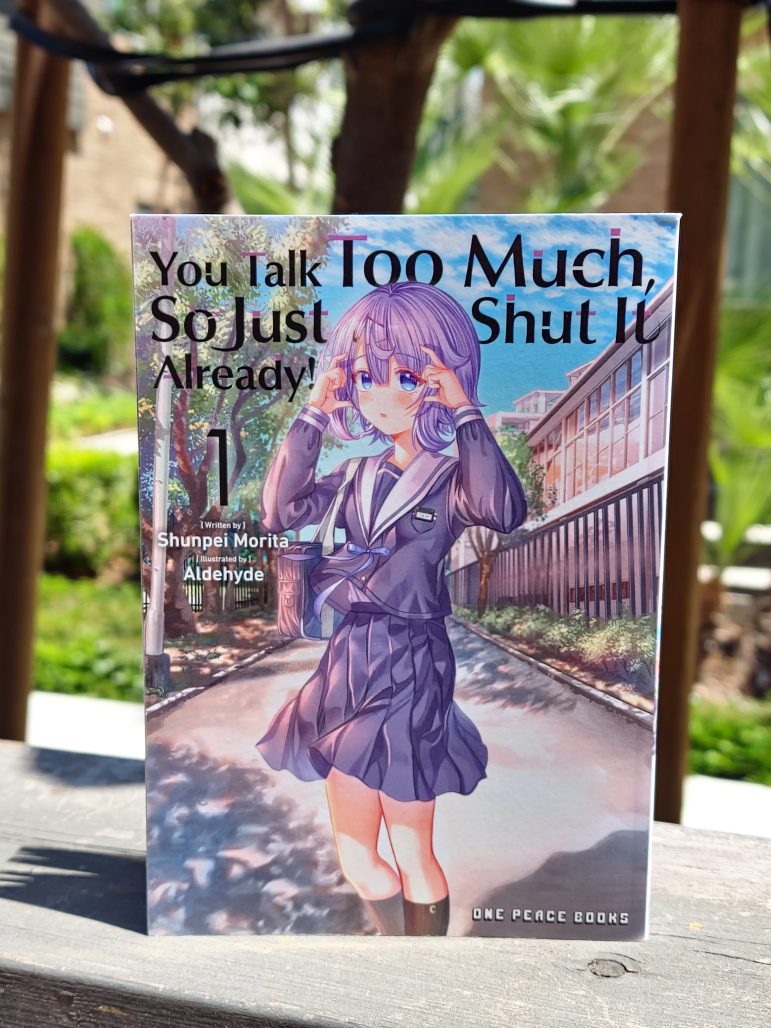
Story: Shunpei Morita
Art: Aldehyde
Publisher: One Peace Books (Print & Digital)
Publication Date: March 4, 2025
Rating: Teen
Genre: Manga, Romance
Tsukino Hiiragi was born deaf. When her oblivious classmate Taiyo Enomoto suddenly starts talking to her, she’s interested. But, as she carefully reads his lips, she starts to wonder: what nonsense is he talking about anyway?
This review contains spoilers for You Talk Too Much, So Just Shut It Already, Vol. 1. I received a free copy from One Peace Books in exchange for a review.
You Talk Too Much, So Just Shut It Already! kicks off with a premise that sounds chaotic on paper but unfolds into one of the most wholesome and unintentionally hilarious manga I’ve read in a while. Our lead, Taiyo Enomoto, is well-meaning but socially oblivious, and just happens to talk a lot. His counterpart is Tsukino Hiiragi, a deaf girl who just transferred into his class. When she signs to let him know she can’t understand him, Taiyo, in true himbo fashion, misinterprets it as her telling a story about a mouse crawling on her. That pretty much sets the tone.
The teacher explains that Tsukino was born deaf but reads lips, so her classmates should face her when they speak. Initially, Tsukino becomes a novelty—students rush to talk to her, which overwhelms her. But Taiyo, undeterred and extremely chatty, continues to talk her ear off. He confidently introduces himself as a “great listener.” (Bless him.) When he finally asks, “Why are you writing and not talking?”—despite the teacher’s earlier explanation—you can’t help but laugh.

Tsukino explains that she communicates through writing and sign language. Taiyo, inspired, decides he’ll bridge the gap with sheer enthusiasm. When she signs to ask when he learned sign language, he believes she’s talking about catching an eel. (Yes, an eel.) He tries to sign back and accidentally calls her cute. The pair reignite interest from their classmates, who begin chattering at Tsukino all at once. Overwhelmed again, Tsukino is saved by Taiyo, who reminds the crowd to speak slowly and be mindful of her needs. It’s a small but sweet moment that shows Taiyo’s heart is in the right place, even if his brain takes a few detours.
The next day, Tsukino’s mind drifts as she wonders where Taiyo is, so much so that she misses something the teacher says. A classmate helps her out, and soon after, Taiyo finally arrives. His excuse? He ran into an elderly woman and couldn’t not help her, so he accompanied her all the way to Kamakura. The randomness of it leaves Tsukino reeling. She starts to wonder: Is his kindness toward her just pity? She signs to ask why he talked to her in the first place, and because Taiyo thinks he can sign, he responds with an elaborate story about a kappa, leaving her completely lost. He then offers to walk her home, which she accepts. Along the way, she witnesses his habit of helping strangers, which gives her hope they could genuinely be friends. Still, she can’t help but find the extent of his kindness… confusing.
Academically, the two couldn’t be more different: Tsukino excels because she works hard and studies ahead, while Taiyo manages an impressively dismal 8 on a test. A classmate, Sakura, volunteers Tsukino to tutor him, which leads to even more misunderstandings. Taiyo insists he’ll understand through “passion,” misreads her signed warning as a threat, and yet somehow passes the retake. So… success?
Sakura begins learning sign language to get closer to Tsukino and quickly asks Taiyo if he knows how to sign. He confidently says yes. A narrator box immediately calls him out: “He does not.” Comedy gold.
One of the manga’s strongest scenes involves Tsukino returning from the restroom only to find her classroom empty. She’s on the verge of panic when Taiyo shows up and guides her to the right room, revealing the class had moved during a teacher’s announcement. Tsukino signs his name in gratitude; he understands this, but thinks she’s threatening to “chop” him. These two cinnamon rolls clearly have no idea what the other is thinking.
Tsukino later suspects students might be gossiping about her, but Taiyo reassures her, and inadvertently calls her cute when confronting the schoolmates who’d been following her around. It’s an accidental but heartwarming moment. Through her tablet’s speech-to-text function, she learns what he said and is genuinely shocked. It’s one of those rare, clear moments where the feelings are mutual, even if neither of them quite realizes it.
The two begin tutoring each other—she helps him in everything else, and he helps her (poorly) in English. After another failed test, Taiyo admits he just wants to spend more time with her. (Cue the “aww.”) He ropes her into joining a club, and Tsukino briefly explores a bunch of sports, revealing she’s naturally gifted. Still, nothing sticks until Sakura recruits them for the Uma Club, a group dedicated to finding cryptids like the tsuchinoko. It’s basically a thin excuse to go on fun adventures, but Taiyo sells it with his usual gusto, and Tsukino goes along for the ride.
A particularly sweet flashback reveals the reason for Taiyo’s immediate friendliness: before they met as classmates, Tsukino saved him (unknowingly) from a Komodo dragon. She gave him her handkerchief for a wound, and though she didn’t hear his thanks at the time, it stuck with him. That little memory reframes everything and adds a surprising emotional weight to the story.
In the final stretch, Sakura tests Taiyo’s signing skills—and while he gets a few words right, he’s still hilariously off-base. But in true manga fashion, Tsukino misreads his bumbling attempts as genuine skill. As the narrator bluntly puts it: “And so, the misunderstandings went deeper.”
You Talk Too Much, So Just Shut It Already! is equal parts adorable and absurd, with a core relationship built on relentless sincerity, endearing cluelessness, and a complete lack of accurate communication. Despite the chaotic misunderstandings, the manga is deeply respectful of Tsukino’s experience as a deaf student and frames Taiyo’s bumbling efforts not as mockery, but as an earnest (if misguided) attempt to connect.
It’s a charming slice-of-life with a unique twist, and if you like soft protagonists, misunderstandings played for laughs, and relationships that develop through chaos and kindness, this manga is an absolute treat.











